Introduction
Hundreds of delegates from around the world converged at Arizona State University (ASU) for the Citizen Science Association’s C*Sci 2023 conference, May 22-26, 2023 to exchange knowledge and help shape and advance opportunities to engage the public in scientific research. Summarizing a week of action-packed days in a single blog post won’t convey the enthusiasm, creativity, congeniality, sense of community and intellectual merit that took place but we hope this snapshot, focused primarily on SciStarter and ASU activities, gives you a flavor of what attendees experienced. We’ve sprinkled in some behind-the-scenes insights and interesting facts, too.
Check out our photo/video gallery featuring highlights from the week.
Monday, May 22
As a preamble to the conference, NASA hosted a meeting of researchers who lead current and future crowdsourcing and citizen science projects we’ll be featuring through “Do NASA Science LIVE!” which is a series of online events starting this summer. See SciStarter.org/NASA-LIVE for details on our first event!
At the conference, Bob Hirshon, the producer and host of the SciStarter Podcast interviewed many NASA project scientists and others whom you’ll learn more about on the podcast and during the “Do NASA Science LIVE!” events.

Marc Kuchner, Citizen Science Officer for NASA’s Science Mission Directorate, opened the NASA meeting with impressive stats including: NASA’s two million volunteer participants from 167 countries (468, and counting, of whom are named co-authors on published papers) have discovered all known samples of interstellar material and most known comets!
Learn about and get involved in NASA-funded citizen science projects anytime.
Then, Elizabeth MacDonald, a program scientist at NASA Goddard Space Flight Center, introduced Heliophysics Big Year (HBY), a global celebration of the Sun’s influence on Earth and the entire Solar System. In addition to monthly events, HBY will help you prepare to view two North American solar eclipses on October 14, 2023 and April 8, 2024.
Find eclipse-related citizen science projects at SciStarter.org/Eclipse, including those supported by NASA.

Gerald “Stinger” Guala, Citizen Science for Earth Systems Program (CSESP) Program Manager at NASA, reported that NASA invests millions of dollars to support public participation and accelerate important research.
SciStarter founder Darlene Cavalier was invited to talk about the SciStarter ecosystem (summarized in the image below), and how the platform is catalyzing crowdsourcing, citizen science and community science while advancing research in the field and engaging people from all walks of life. Cavalier referenced research partnerships with Caren Cooper’s Public Science Lab, North Carolina State University (NC State) resulting in published papers and interesting research outcomes. For example, because of SciStarter, we now know that volunteers typically engage in three or more projects, across topics.

Find more citizen science research outcomes at SciStarter.org/Research, and learn more about SciStarter at SciStarter.org/About.
Other interesting highlights from citizen science project leaders and researchers:
- Rob Zellem from Exoplanet Watch mentioned that operating the James Webb telescope for an hour costs anywhere between $100,000 and one million dollars. Exoplanet Watch lets anyone learn about planets that orbit stars beyond our Solar System and get involved in observing them.
- Nora Eisner from Planet Hunters TESS explained how volunteers detect data in online images that algorithms tend to miss. The Transiting Exoplanet Survey Satellite (TESS) is generating a huge amount of data that allows looking for planets outside of our own Solar System, and citizen scientists are requested to classify graph images on the project page. The findings may even bring us one step closer to answering the question that we all seek to answer: are we alone in the Universe?
- Chuck Higgins from Radio JOVE praised the SciStarter training modules and recommended project leaders design opportunities to trust their community to let participants help each other out, and the project representatives may simply chime in from time to time, to correct or clarify any misconceptions. Radio JOVE students and amateur scientists from around the world observe and analyze natural radio emissions of Jupiter, the Sun, and our galaxy using their own easy-to-construct radio telescopes.
- Heather Fischer from Oregon State University who researches and evaluates GLOBE Observer and Aurorasaurus in addition to ScienceNearMe.org, opened a discussion with this panel with an out-of-this-world statement: “Some projects are not just global, but also universal.” GLOBE Observer is a citizen science app allowing volunteers to contribute to the Global Learning and Observations to Benefit the Environment (GLOBE) community by collecting data to track changes in the environment in support of Earth system science research, and interpret NASA and other satellite data. Aurorasaurus, on the other hand, tracks auroras around the world via reports on their website and social media, with all aurora-related tweets and reports getting placed on the Aurorasaurus.org map, and participants are then asked to log in and verify the tweets or reports.
- Allison Cusick, a PhD candidate and project leader at Fjord Phyto, described how her team engages tourists to research polar phytoplankton dynamics using field and satellite observations. The project was developed as a partnership between scientists in the USA, Argentina and the Antarctic travel industry (the Antarctic peninsula is one of the fastest-warming regions in the world). Cusick explained how the project is being integrated into PRO OCEANOS: short for Ocean Community Engagement and Awareness Using NASA Observations and Science for low-income hispanic/latino students.
- Russanne Low, from the GLOBE Observer: Mosquito Habitat Mapper project, explained how volunteers are helping to reduce the risk of vector-borne diseases by using an app to report sightings of mosquitos and more. Marc Kushner added that volunteers have already decommissioned by eliminating 8,900 (and counting) mosquito breeding sites. SciStarter and ASU co-created a suite of kits now available in libraries, including one for Mosquito Habitat Mapper containing mini microscopes and other materials to help people participate.
- Mike Hartinger from the Heliophysics Audified: Resonances in Plasmas (HARP) project reported more than 1,200 people are listening to online audio files to help understand how solar storms change the sounds of space.
- Caren Cooper from the Inclusive, Diverse, Equitable, Accessible and Large-scale (IDEAL) program described the National Science Foundation-support program which aims to create and deploy a framework to guide inclusive practices in large-scale participatory science projects. Look for the IDEAL tutorial on SciStarter.org/Training later this year.
Find more updates on NASA-supported initiatives at the end of this post.
Welcome Reception: C*Sci 2023 officially kicked off at the welcome reception, hosted by ASU and SciStarter and the beautiful Tempe Mission Palms Hotel. Attendees reunited with or met new friends, interacted with ASU-supported programs (including SciStarter), relaxed and heard from David Guston, Foundation Professor and founding director of the School for the Future of Innovation in Society and Associate Vice Provost for Discovery, Engagement and Outcomes within the Julie Ann Wrigley Global Futures Laboratory. Dave singled out SciStarter’s recent award for social embeddedness from ASU President Michael Crow, and described how our work aligns with ASU’s globally-driven work developing low-cost tools, participatory policy making through our partners at ECAST, and other “close cousins” of citizen science.
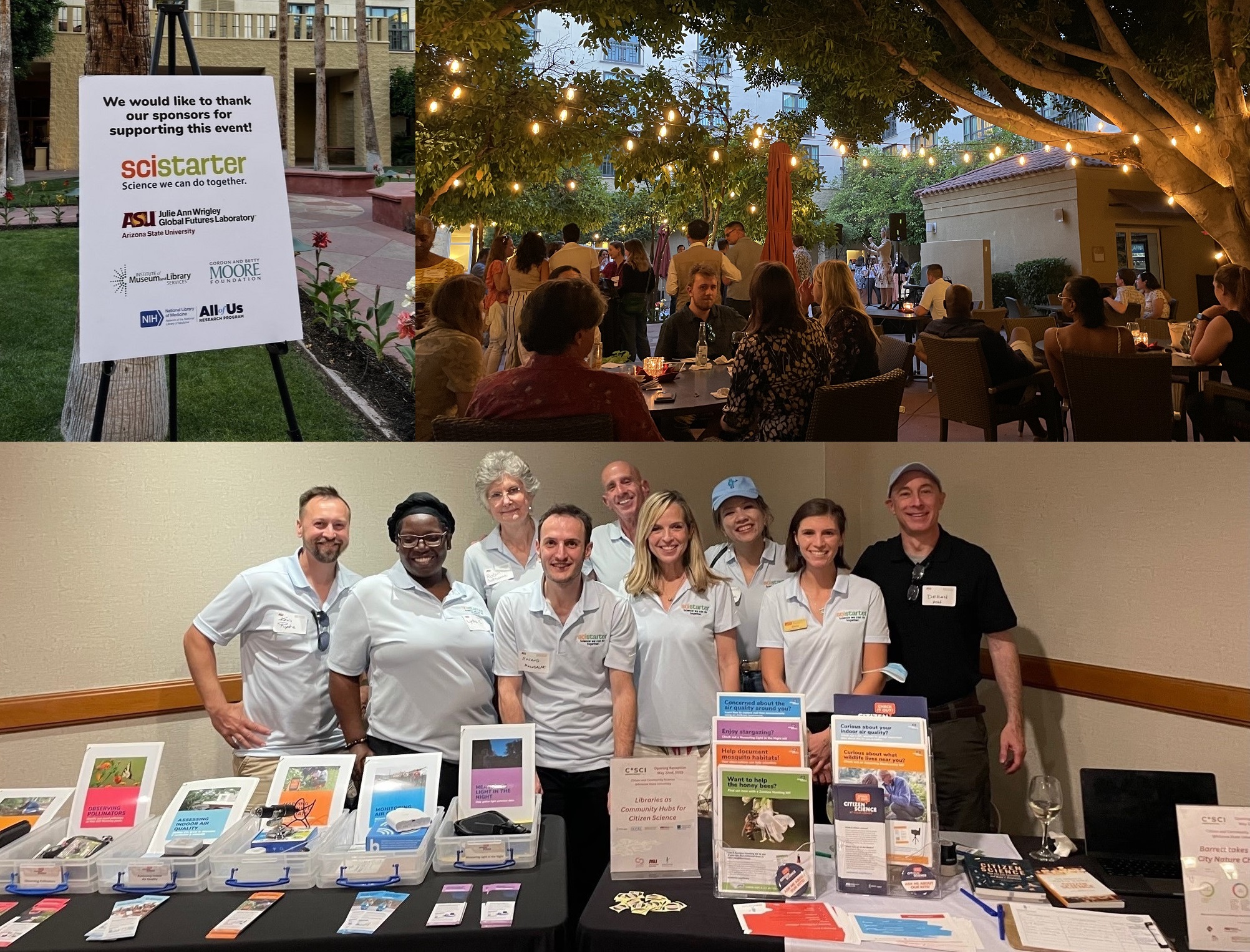
Tuesday, May 23
SciStarter Workshop: Caroline Nickerson kicked off the second day of the conference with a workshop and navigated through the rich and free offerings from SciStarter for various types of users. Tables were set up to support attendees seeking to add/promote their project, connect with library kits, access data analytics for research, and provide recommendations to improve SciStarter. I was happy to assist principal investigators in making their projects and events more discoverable on our platform.
Exhibit Table: we really enjoyed sharing information about our “Libraries as Community Hubs for Citizen Science” program and hearing feedback on how to improve the program and make it more accessible to more libraries, museums and other “third spaces”! Click here or watch the video below.
At noon, Jennifer Shirk (executive director, C*Sci Association) introduced the opening plenary session entitled “What would it take to really share scientific power?” which was moderated by Mónica Ramírez-Andreotta (CSA board member and associate professor of environmental science at the University of Arizona in Tucson). The invited guests were Kenja Hassan (associate vice-president, Office of Government and Community Engagement at ASU) and Angela Chalk (founder and executive director at Healthy Community Services). The speakers suggested a range of best practices towards addressing equitable approaches to participatory research.
A symposium followed the plenary session – Sharing successes and challenges in producing research with C*Science methodology: 4 case studies in Earth and Space Sciences – moderated by Ramanakumar Sankar, project leader of Jovian Vortex Hunter, a project that asks volunteers to classify photos of Jupiter clouds to better understand the planet’s atmosphere. I’ve included my notes on this symposium towards the end of this post.
Tuesday concluded with a tasty dinner in the Arizona Ballroom in the Memorial Union, in parallel with the launch of Wild Hope, a series of half-hour films highlighting the intrepid changemakers who are restoring and protecting our planet. The first film of the series, “The Big Oyster,” included beautiful storytelling to illustrate the oyster’s immense ability to clean the water in which this tiny-but-mighty creature lives. I really enjoyed this experience and look forward to viewing the full series, including Beaver Fever, Woodpecker Wars, Does Nature Have Rights?, The Beautiful Undammed, Coffee for Water, Salamander of the Gods, and Canine Conservationists.
Wednesday, May 24
The next morning, more than 40 people joined the roundtable discussions focused on the Heliophysics Big Year! Attendees included those who were completely new to the HBY program with jobs that were unrelated to space (biology, architecture, etc.), to NASA folks who do this kind of work on a daily basis, and everyone in-between. After some 40 minutes passed as we took turns introducing ourselves, Elizabeth MacDonald (moderator) left the attendees to mingle and share their experiences in a one-on-one fashion. Needless to say, this kind of immersive interaction can only be achieved during in-person events, as opposed to online meetings and webinars.
…And it’s time for the symposium! “Sharing successes and challenges in producing research with C*Science methodology: 4 case studies in Biology, Biomedical and Health Science”:
Not all projects on Zooniverse are space-themed, and Maturity of Baby Sounds is a great example, as Chiara Semenzin (Département d’Études Cognitives, École Normale Supérieure) showed us. Leveraging the platform’s very useful tutorial feature, this project studies the sounds children make, and participants are also asked to categorize the sounds people around those babies make. Definitely worth checking if you love babies (who doesn’t)! Below are some of the project’s findings:
- Children’s speech development is very similar across languages and cultures.
- Children at risk of language impairment show different patterns, which could help in identifying intervention points.
It’s always interesting to hear from Pietro Michelucci about the Human Computation Institute’s very popular project – Stall Catchers – that lets volunteers report clogged blood vessels in movies of mouse brains. A recent sensitivity analysis proved that the most accurate results were obtained by combining the “guesses” from humans and the AI, followed by results obtained from humans alone, with bot-exclusive guesses yielding the least accurate results. It should be interesting to see what the sensitivity analysis might show a few years from now!
Here’s some more insight for all AI fans (and skeptics) out there, brought to you by Isil Poyraz Bilgin (postdoctoral researcher, NeuroAI). Her presentation, entitled “Citizen Science Meets NeuroAI,” highlighted some of the challenges that any citizen science project might face, not only AI-oriented ones:
- Scientific communication is a skill to be acquired.
- Maintaining dialogue with the community is impacted by the lack of continuity in resources.
- Collection of the demographic information might be affected by governmental regulations and policies.
- Repetitive and boring tasks might affect the motivation of the participants.
- Sometimes science is slower than expected and feedback might be delayed.

Symposium: Libraries as Community Hubs for Citizen Science, presented by SciStarter, Arizona State University and our partner libraries! We used a “fishbowl model” which is a form of dialogue that enables everyone to participate in the fluid but structured discussion. We wanted to explore how to support libraries as important facilitators and conduits to diverse audiences.
- Introduced by Darlene Cavalier and moderated by Laura Bartock (community science fellow at the Association of Science and Technology Centers) and Lydia Collins (SciStarter and PhD candidate), this engaging session hosted a packed audience and 8 pre-seeded speakers: Robin Salthouse (library specialist, SciStarter), Vivienne Byrd (Los Angeles Public Library), Lisa Lewis (AZ State Library Association), Tracey Charlie (Acoma Pueblo Library), Theresa Schwerin (Institute for Global Environmental Strategies “IGES”), Kirsten Crowhurst (NNLM All of Us Program Center “NAPC,” University of Pittsburgh), Rachael Van Schoik (Science Action Club, California Academy of Sciences) and Nicole Colston (Oklahoma State University).
- Lisa Lewis: “SciStarter.org/Library provides us with invaluable resources.”
- One panelist even went on to say that some communities don’t have community centers, and that libraries are playing that role.
- Vivienne Byrd agreed that citizen science can be a way to adapt scientific topics to different cultures.
- Theresa Schwerin quoted a proverb that goes like this: “If you want to go fast, go alone, but if you want to go far, go together,” and this principle applies to integrating citizen science in libraries.
- Rachael Van Schoik described her positive experiences with libraries as they relate to the Science Action Club.
- The above shows how citizen science positions libraries as two-way knowledge production hubs, where patrons not only acquire knowledge, but also produce knowledge.
Darlene gave a shout out to many of the people who create and manage “version controls” of library kit and project materials on the SciStarter website.

This session provided much-needed, face-to-face discussions between facilitators, project scientists, and librarians and resulted in a new “working group” within the National Citizen and Community Science Library Network(!!). The working group will help design roadmaps to foster best practices for project scientists to collaborate with libraries and vice versa. This will also build on guides, trainings and a host of resources currently available on SciStarter.org/Library, thanks to support from the Institute for Museum and Library Services, the Moore Foundation, and National Library of Medicine, National Institutes of Health, Department of Health and Human Services under Cooperative Agreement Number U24LM014070 with the University of Pittsburgh, Health Sciences Library System and the University of Iowa, Hardin Library for the Health Sciences.
Darlene also announced plans for a special collection/edition of the CSA’s peer-reviewed journal (Theory and Practice) focused entirely on C*Sci in Libraries and Museums. Email info@SciStarter.org to receive updates on that.
Poster session
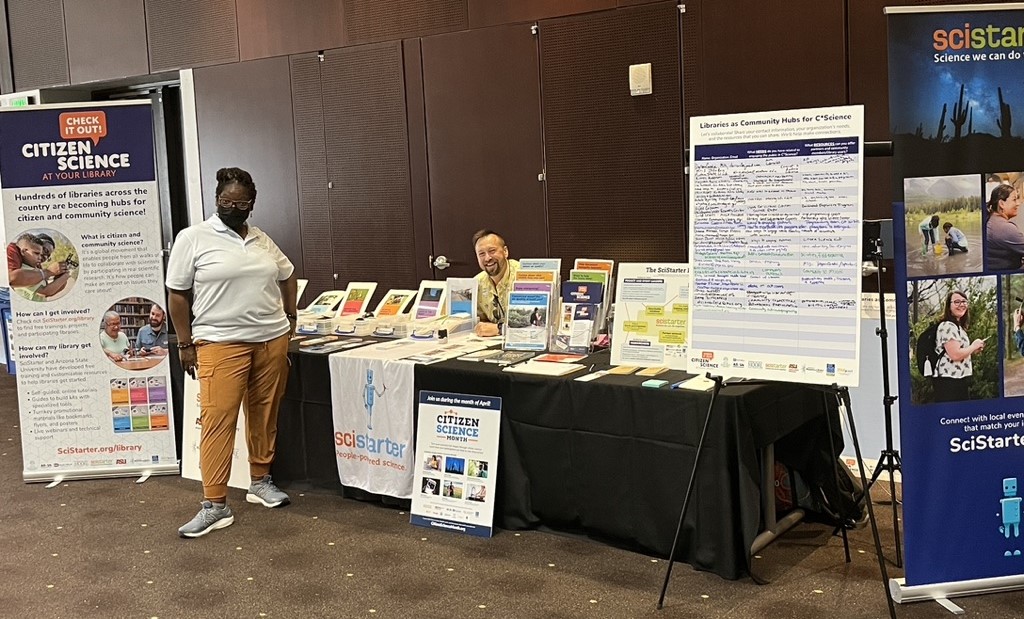
SciStarter’s Ecosystem poster basically outlined lesser-known features and offerings made possible by SciStarter, a public-facing research affiliate of ASU and NC State, connecting millions of people to thousands of crowdsourcing projects. The platform offers:
- Project finder: search and find projects by activity, location, indoor/outdoor, interest, online/offline, age level and more.
- SciStarter.org/Training: learn the basics and engage in projects guided and supported by interactive tutorials designed by instructional designers at ASU.
- SciStarter.org/Add: add a project, event or tool, and fill as many fields as possible to make it more discoverable for citizen scientists. Plus, adding a project to SciStarter automatically includes it on our sister site, Science Near Me.
- Targeted recruitment: use features like the People Finder to find the right volunteers.
- Enhanced promotions and analytics: APIs and resources to connect with partners including Girl Scouts, libraries, corporate volunteer programs and more, and tools to help volunteers track participation across websites and apps; leverage SciStarter’s large communications platform including a podcast, blog on DiscoverMagazine.com, social media, newsletters, emails, monthly articles in the National Science Teaching Association magazines, weekly events and more.
- On-demand project analytics: click the “data” link from your project page to learn more about your participants and how your project relates to others.
Deron Ash (ASU), Darlene Cavalier (ASU, SciStarter), Jeannie Colton (ASU), Megan Jehn (ASU), Robin Salthouse (SciStarter) presented this poster on “Developing Citizen Science Kits with and for Libraries: Lessons Learned.”
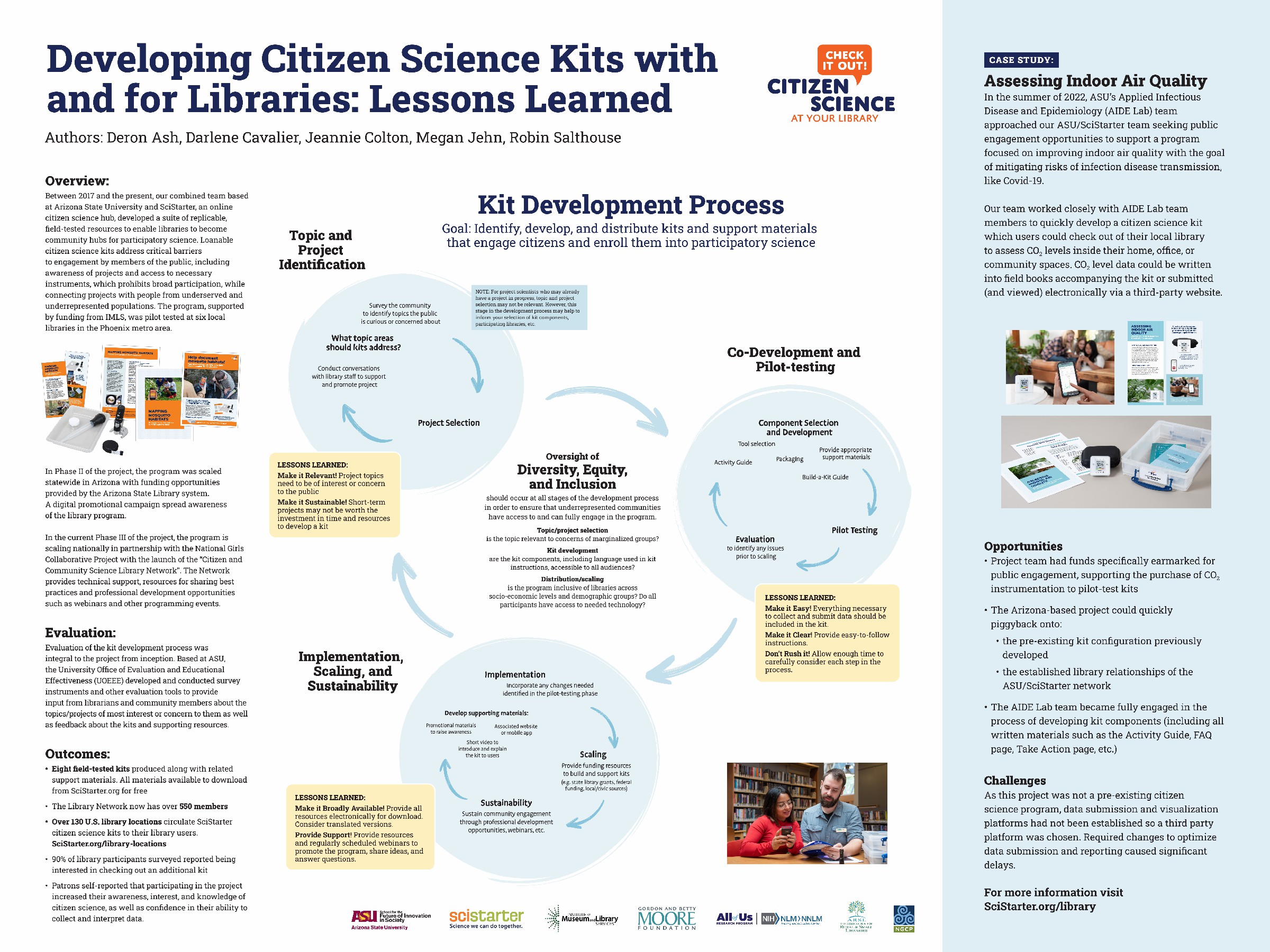
SciStarter partnered with ASU researchers from the School of Human Evolution and Social Change, who create awesome DIY CO2 monitoring filters, to quickly codevelop a new kit for loan through libraries. Check out this poster to see what we discovered and achieved during our pilot project in Phoenix!

Thursday, May 25
Symposium: “Sharing successes and challenges in producing research with C*Science methodology: 4 case studies in Ecology and Environmental Science.” We learned several things during this symposium, including the following:
Neat fact: while cats are the number one reason for bird deaths, bird-building collisions ranks second.
Cool fact: sponges are some of the most ancient and primitive animals in the world.
At noon, we headed to Mesa Public Library for an event organized by SciStarter and ASU:
- Elizabeth MacDonald talked about the Heliophysics Big Year and the Aurorasaurus citizen science project.
- Tanya Palit (Applied Infectious Disease and Epidemiology “AIDE” project manager) introduced the DIY air purifier, alongside the indoor air quality monitor (which is in one of SciStarter’s library kits).
- Pietro Michelucci described Beta Catchers, a CitSci project that’s coming soon which, if it turns out as remotely popular as Stall Catchers, will become another success story in the field.
- Marilé Colón Robles (project scientist) and Tina Rogerson (data
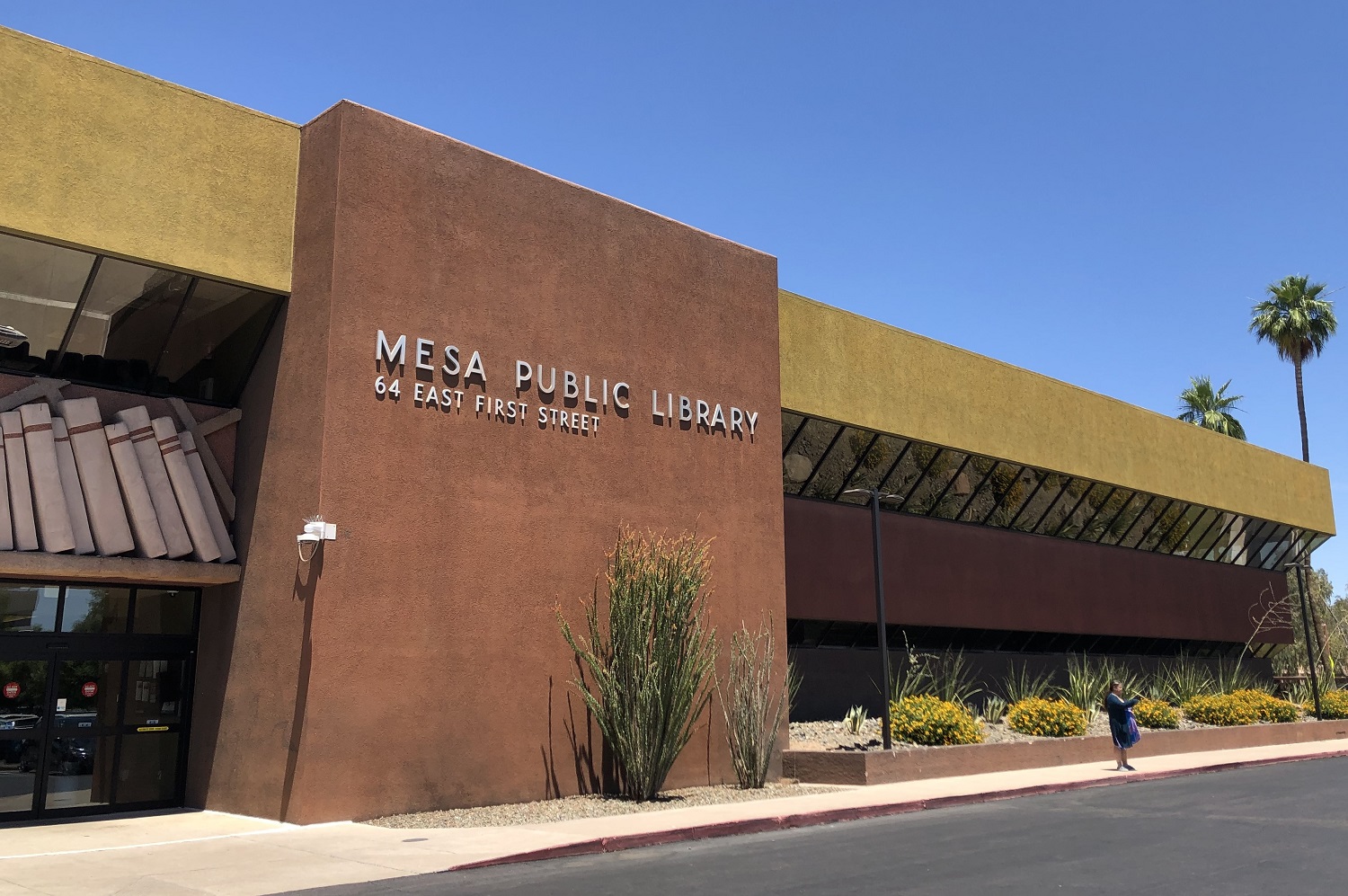
Mesa Public Library manager) announced that the GLOBE Observer: Clouds project has recently reached the 1,000,000th observation! After a volunteer downloads the app, they would photograph clouds to help scientists understand the sky from above and below by comparing the photos with NASA satellite images.
Neat fact: a cloud can weigh more than a million pounds!
The day wasn’t over yet, and the last “Talks, Discussions” session of C*Sci 2023 included but wasn’t limited to the projects below:
- Sociedad Ambiente Marino (SAM), which is the oldest community-based reef aquaculture and restoration program in the Caribbean. Frances Candelas explained how the work of a volunteer can become a legacy, and she urged us to protect and restore the Earth, adding that conserving a quarter of the planet isn’t enough.
- EwA, short for Earthwise Aware, is a community of data-driven naturalists who are helping to address the many challenges that urban spaces and the natural world face. EwA president Claire O’Neill described their participatory science process in 4Ps: procedural (methodical), purposeful (actionable), people-driven and public (open).
- Michael Dawson (FrogWatch chapter coordinator) elaborated on how acoustic citizen science projects can benefit and complement traditional bioacoustics surveying. The project aims to collect data about frog and toad populations to help conserve amphibians.
Neat fact: audio observations (e.g., frog calls) are easier to identify than photo observations (e.g., frog images), even when the audio recording isn’t high-quality.
This week, SciStarter LIVE (a weekly online event series, open to the public each Tuesday at 2pm ET) was unlike any other: click here or watch below as we interviewed various project representatives during the poster session!
Friday, May 26
Entitled “Equitable Research Partnership Tools for Communities and Researchers,” the only workshop of the day (and, I felt, one of the most thought-provoking workshops of the conference) focused on how marginalized (particularly Black) communities can leverage citizen and community science to combat inequality:
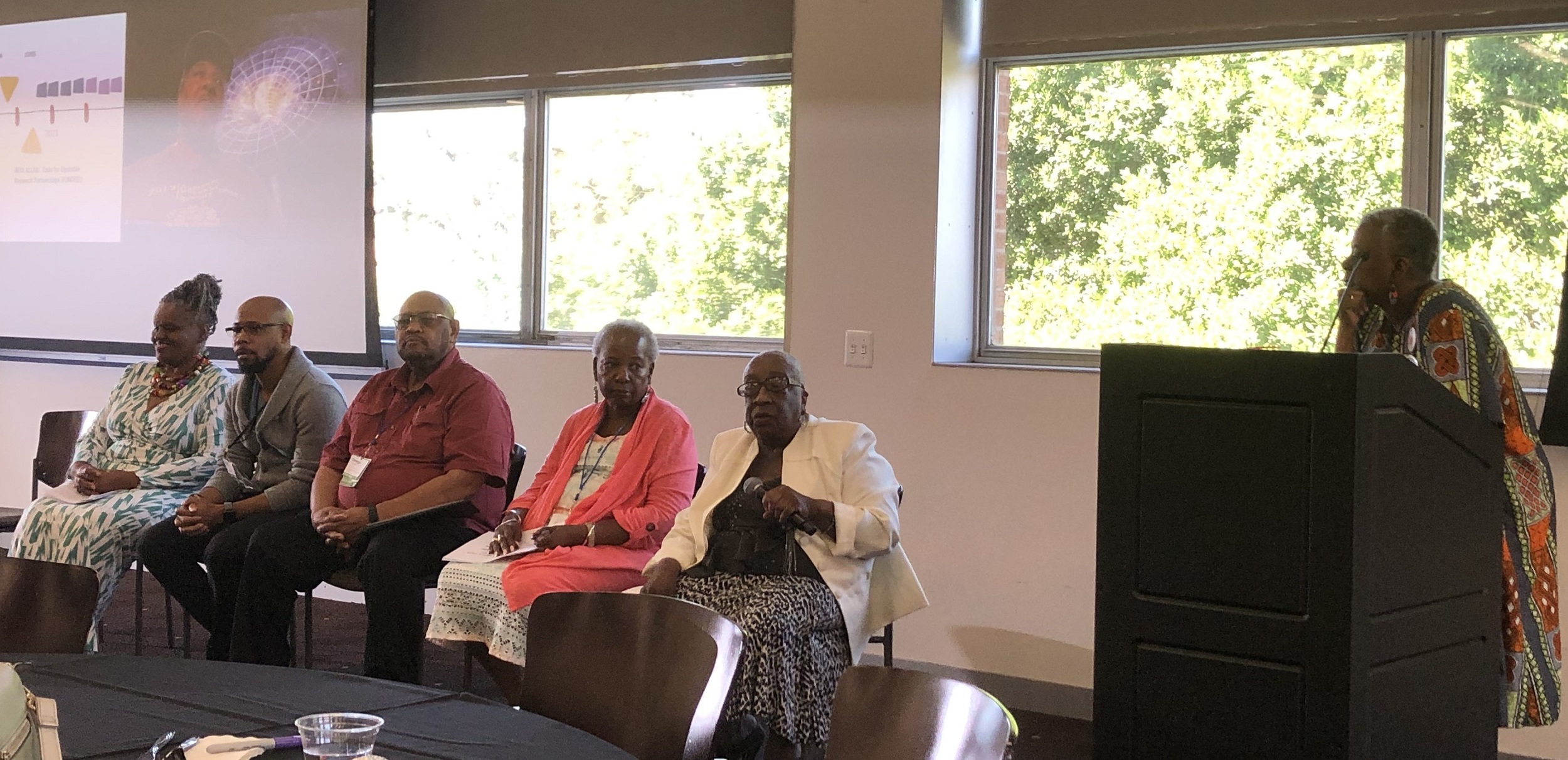
- The environmental justice practitioners’ working group members are: Antonio Garcia (coordinator), Vincent Martin (co-chair), Ms. Veronica Bitting (co-chair), Ms. Margaret Gordon, Dr. Valerie Ann Johnson, Omega and Brenda Wilson (advisors), and Ms. Janice Hunter.
- Omega and Brenda Wilson are also co-founders of the West End Revitalization Association, known as “WERA.”
- Ms. Margaret Gordon was thankful for Caren Cooper who attended the workshop, for playing a key role in introducing citizen science to her community, years ago.
- Brenda Wilson: “Wherever you go, make sure that you’re accountable to your community, and that your community is also accountable.”
- Ms. Veronica Bitting quoted one of her colleagues by saying “I don’t like revolutionaries as much as I do solutionaries,” and she explained how social determinants of health can influence health equity in positive and negative ways, including income and social protection, education, unemployment and job insecurity, working life conditions, food insecurity, housing, basic amenities and the environment, early childhood development, social inclusion and non-discrimination, structural conflict, and access to affordable health services of decent quality.
- At least 19 participants joined a small group prompt over Zoom, in addition to more than 30 people in the room, sharing thoughts with each other for 10 minutes, discussing how each person was going to use the newly-acquired information to become more inclusive in citizen science endeavors.
- Tira Beckham (NC State University) argued that researcher “legitimacy” supplements community work, especially when the data is co-produced. One of Beckham’s slides read: “Traditional knowledge production that values the peer-reviewed system over lived experiences reinforces the erasure of community voices and advocacy efforts.”
- Marc Kuchner was particularly interested to learn how NASA – through thoughtful grants – can help environmental justice initiatives to scale up.
- Omega Wilson touched on a very important issue, similar to what Kenja Hassan said days earlier in the conference (about how the media can bias the work of scientists): when someone from a minority group climbs the academic/professional ladder, they might get trained out of their identity, getting left with the right job title but without the proper skills to make positive change in their own communities. Wilson suggested that “the solution would be to get over ourselves to understand the problems and find the proper solutions.”
- We also got to learn about the West Oakland Environmental Indicators Project, known as “WOEIP,” which gives impacted residents the tools to participate in the political, social, and natural forces that impact their lives through environmental justice, air quality research and coalition building.
Neat fact: in 2008, Intel had a prototype project in the City of Berkeley, and Intel staff trained WOEIP staff and residents how to use the technology equipment known as a TSI Dust Tracker.
The speakers shared nine tips to promote fairness, collaboration and respect between researchers and communities, by involving community members in research planning and decision making:
- Teach and empower: provide training and resources to help community members participate effectively.
- Share information openly: communicate research findings clearly and in a way that everyone can understand.
- Respect community priorities: focus on the issues that matter most to the community.
- Share power: make decisions together and address any imbalances of power.
- Be ethical and get consent: follow ethical guidelines and obtain permission from community members.
- Share resources fairly: ensure that benefits and resources are distributed equitably.
- Build long-term relationships: aim for lasting partnerships beyond one research project.
- Create and share knowledge: work together to generate knowledge and share it widely.
- Learn and improve: regularly evaluate the partnership and use feedback to make it better.
Conclusion
With C*Sci 2023, the Citizen Science Association celebrated its 10th anniversary!
A huge thank you to everyone at CSA who made this conference possible, in partnership with SciStarter, and to ASU which hosted the conference! And a big shout-out to Reanna Putnam (community engagement specialist, CSA) and Liv Vega (events coordinator, CSA), Caren Cooper (and her awesome team at NC State), our collaborators from the Arizona SciTech Institute including Kaci Fankhauser and the awesome Chief Science Officers, and Cindy Dick and Molly Dean from ASU event planning.
SciStarter team members include Darlene Cavalier (Pennsylvania), Bob Hirshon (Maryland), Caroline Nickerson (Florida), Daniel Arbuckle (Washington), Deron Ash (Arizona), Emma Giles (Arizona), Jill Nugent, Lydia Collins (California), Kevin Ripka (Iowa), Lea Shanley, Robin Salthouse (Washington), Roland Moundalak (who flew in from Lebanon!), Tara L. Cox, and Trevor Bartone (Ohio). Emma and Deron, our local coordinators, really nailed it …all with a smile!
Field trips
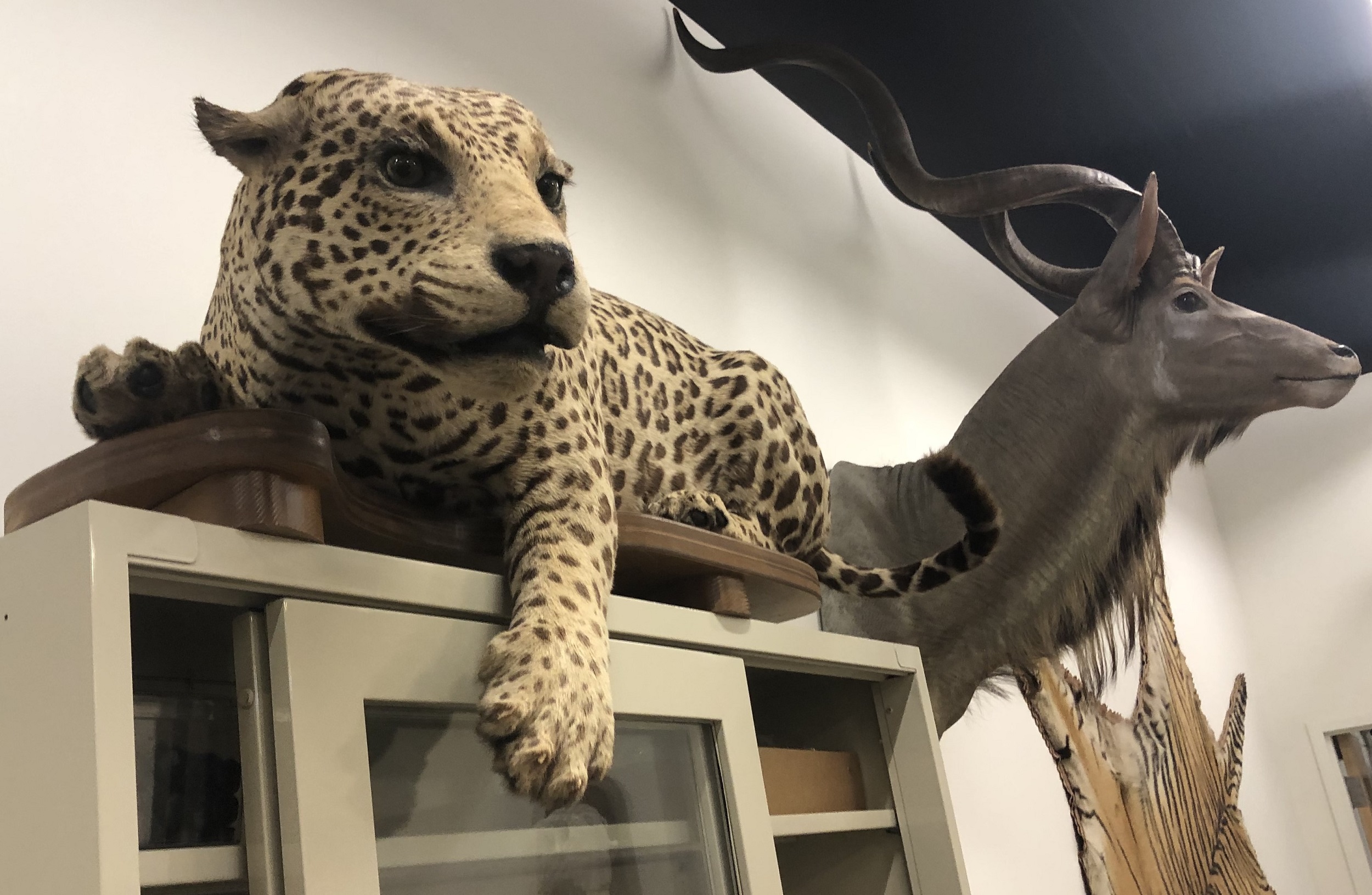
Monday afternoon, we toured the ASU Natural History Collections where we learned about biodiversity data portals SEINet and Symbiota as well as WeDigBio, a public-facing site where volunteers transcribe and digitize museum specimen labels, and BIOSPEX, a resource for launching, advertising and managing targeted efforts to digitize the world’s three billion biodiversity research specimens in ways that involve the public.
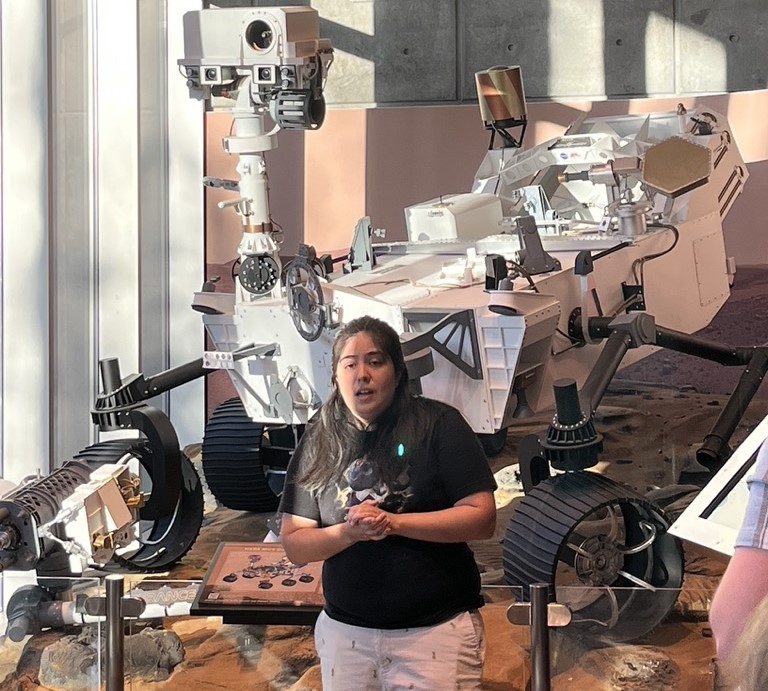
Before the third day of the conference – Wednesday – was over, it was time for a field trip unlike any other, in ASU’s Interdisciplinary Science and Technology Building IV. The friendly (and highly-knowledgeable) staff gave us a tour of the building, and the most fascinating stuff we saw included a 1:1 model of the NASA Mars Perseverance Rover, ancient space rocks (which we were allowed to touch!) and a live-narrated 3D projection of the milky way galaxy (in the ASU Marston Exploration Theater). The must-see photos and videos can be found in SciStarter’s C*Sci 2023 gallery.
Additional notes
Below are my notes from the May 23 symposium entitled “Sharing successes and challenges in producing research with C*Science methodology: 4 case studies in Earth and Space Sciences”:
- Karl Battams, project leader of The Sungrazer Project, a 23-year old NASA-funded citizen science project enabling the discovery of comets in ESA and NASA Heliophysics imaging observations. According to Battams, the project not only grew organically, as he tries not to insert himself in the community discussions, but the users also moderate the chat rooms themselves, keeping trollers out, which echoes with what Chuck Higgins (project leader of Radio JOVE) said about the importance of the community. Battams went on to say that citizen science is the only practical means for thoroughly mining the project’s data.
- Nora Eisner made another presentation about Planet Hunters TESS and, when asked about her wish list as a project leader, she mentioned the ability to have a more diverse user base (not just older men). This shows that the challenge of diversity in the CitSci field isn’t limited to race, but also age and (probably) other criteria, too.
Cool fact: well over half of all officially documented comets have been discovered by The Sungrazer Project’s citizen scientists.
Some insights from the talks and discussions session:
- While it shouldn’t come as a surprise that low-cost sensors (including those that come in smartphones) are revolutionizing the field of citizen science, SciStarter is proudly helping accelerate the adoption of library kits which feature several of those sensors.
- The “HydroColor: Water Quality App” (available on Android and iOS) is an example of a smartphone-based sensor, utilizing the camera to determine the reflectance of natural water bodies, and the Chesapeake Water Watch is one project that puts this app to good use. The goal is to collect data with simple-to-use scientific equipment and smartphone applications, and these measurements collected by people on the ground will be used by researchers to “train” the satellites to accurately monitor the Chesapeake Bay.
- Examples of standalone sensors include portable turbidity meters and handheld fluorometers.
Next up was Globe at Night with Connie Walker (scientist at NSF’s NOIRLab) who mentioned that this project has been running for 17 years. It simply consists of measuring the night sky brightness to raise awareness about light pollution which, while usually overlooked, significantly affects astronomical observations, human health, wildlife, cultural heritage, energy, safety and cost.
Cool fact: using Globe at Night, NOIRLab broke a Guinness Book world record for the most users to take an online environmental sustainability lesson in 24 hours.
Neat fact: the number of visible stars decreased by an amount that can be explained by an increase in sky brightness of 9.6% per year in the human visible band, which is equivalent to doubling the sky brightness every 8 years.
Aaron Meisner (assistant astronomer at NSF’s NOIRLab) took the stage on behalf of the Backyard Worlds: Planet 9 collaboration, sharing an interesting approach to increase user engagement: with around 300 of 80,000 (~0.4%) of registered users being “super users,” Meisner suggested “buddy” programs as a way to increase that percentage, by pairing advanced users with newer users. Furthermore, press releases can be a great way to recruit new people, which falls in line with what Nora Eisner said in the previous session – Planet Hunters TESS usually sees a spike in participation following press releases. “Backyard Worlds: Planet 9” searches the realm beyond Neptune for new brown dwarfs and planets, asking participants to view short videos and flag moving objects.
Remaining with space-themed projects, Lindsay House (creator of Dark Energy Explorers) shared the successes and failures of using citizen science in combination with machine learning. Dark Energy Explorers users are asked to identify signals from distant galaxies to help scientists understand dark energy.
- HETDEX (Hobby-Eberly Telescope Dark Energy Experiment) is a $42,000,000 project which will help narrow down our theories of dark energy, by collecting data of ~1 billion spectra, ~1 million distant galaxies and ~1 million nearby galaxies.
- Successes: learned how to train participants and how to collect over 3 million classifications; the obtained information confirmed what was already known.
- Failures: did a lot of work and not much to be done with the result; the information confirmed what was already known!
- Crucially, and just like we mentioned earlier, House reinforced that “sharing results has been a really great way to keep the public engaged.”
On another note, here is my review of the European Citizen Science Association’s conference on October 5-8, 2022!

